Bevin Boys
Bevin Boys were young British men conscripted to work in the coal mines of the United Kingdom, between December 1943 and March 1948,[1] in order to increase the rate of coal production, which had declined through the early years of World War II.[2] The programme was named after Ernest Bevin, a former trade union official and then British Labour Party politician who was Minister of Labour and National Service in the wartime coalition government.[3]
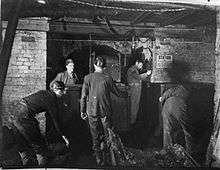
Chosen by lot as ten percent of all male conscripts aged 18–25, plus some volunteering as an alternative to military conscription, nearly 48,000 Bevin Boys performed vital and dangerous civil conscription service in coal mines. Although the last ballot took place in May 1945 (shortly before VE Day), the final conscripts were not released from service until March 1948. Few chose to remain working in the country's coal mining industry after demobilisation; most left for further education or for employment in other sectors.[4]
During their time at the mines, Bevin Boys were targets of abuse from the general public, who mistakenly believed them to be draft dodgers or cowards and they were frequently stopped by the police as possible deserters.[4] Unlike those who had served in the military, Bevin Boys were not awarded medals for their contribution to the war effort and official recognition by the British government was only conferred in 1995.[4]
Creation of programme
Shortfall in UK coal output
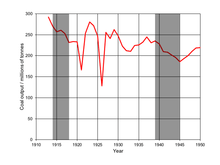
At the start of World War II, the UK was highly dependent on coal, not only to power ships and trains, but as the main source of energy for electricity generation.[5] Although output from mines had increased as the world economy recovered from the Great Depression, it was in decline again by the time war broke out in September 1939.[2]
At the beginning of the war the Government, underestimating the value of strong younger coal miners, conscripted them into the armed forces. By mid-1943 the coal mines had lost 36,000 workers, and they were generally not replaced, because other likely young men were also being conscripted to the armed forces.
Industrial relations were also poor: In the first half of 1942, there were several local strikes over wages in the first half of 1942 across the country,[6][7] which also reduced output.[8] In response, the government increased the minimum weekly pay to 83 shillings (for those over the age of 21 working underground)[8] and established a new Ministry of Fuel, Light and Power, under the leadership of Gwilym Lloyd George to oversee the reorganisation of coal production for the war effort.[9] In late summer, a bonus scheme was proposed to reward workers in mines that exceeded their output targets.[10] These measures resulted in an increase in production in the second half of 1942,[11][12] although volumes were still short of the tonnage required.[13]
Absenteeism (miners taking time off work as a result of e.g. sickness) also rose through the war from 9.65% in December 1941 to 10.79% and 14.40% in the Decembers of 1942 and 1943 respectively.[14]
By October 1943, Britain was becoming desperate for a continued supply of coal, both for the industrial war effort and for keeping homes warm throughout the winter.
Appeals for volunteers
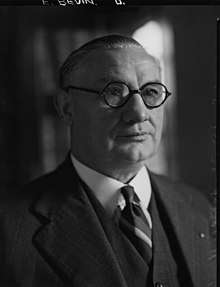
On 23 June 1941, Bevin made a broadcast appeal to former miners, asking them to volunteer to return to the pits, with an aim of increasing numbers of mineworkers by 50,000.[15] He also issued a 'standstill' order, to prevent more miners being called up to serve in the armed forces.[16]
On 12 November 1943, Bevin made a radio broadcast aimed at sixth-form boys, to encourage them to volunteer to work in the mines when they registered for National Service. He promised the students that, like those serving in the armed forces, they would be eligible for the government’s further education scheme.[17][18]
- We need 720,000 men continuously employed in this industry… This is where you boys come in. Each one of you, I am sure, is full of enthusiasm to win this war. You are looking forward to the day when you can play your part with your friends and brothers who are in the Navy, the Army, the Air Force… But believe me, our fighting men will not be able to achieve their purpose unless we get an adequate supply of coal… So when you go to register and the question is put to you "Will you go into the mines?” let your answer be, "Yes, I will go anywhere to help win this war".
- Ernest Bevin, 12 November 1943[18]
The term Bevin Boys is thought to originate from this broadcast.
Conscription
On 12 October 1943 Gwilym Lloyd George, Minister of Fuel and Power, announced in the House of Commons that some conscripts would be directed to the mines.[19] On 2 December Ernest Bevin explained the scheme in more detail in parliament, announcing his intention to draft 30,000 men aged 18 to 25 by 30 April 1944.[20][21]
From 1943 to 1945 one in ten of young men called up was sent to work in the mines. This caused a deal of upset, as many young men wanted to join the fighting forces and felt that as miners they would not be valued.
The first Bevin Boys began work, having completed their training, on 14 February 1944.[22]
Programme
Selection of conscripts
To make the process random, one of Bevin's secretaries each week, from 14 December 1943, pulled a digit from a hat containing all ten digits, 0–9, and all men liable for call-up that week whose National Service registration number ended in that digit were directed to work in the mines, with the exception of any selected for highly skilled war work such as flying planes and in submarines, and men found physically unfit for mining. Conscripted miners came from many different trades and professions, from desk work to heavy manual labour, and included some who might otherwise have become commissioned officers.
An appeals process was set up, to allow conscripts the opportunity to challenge the decision to send them to the pits, although decisions were rarely overturned.[23] Those who refused to serve in the mines were imprisoned.[24][25][26] By 31 May 1944, 285 conscripts had refused to serve as miners, of whom 135 had been prosecuted and 32 had been given a prison sentence.[27] By the end of November 1944, out of a total of 16,000 conscripts, 143 had refused to serve in the mines and had been sent to prison, some with the imposition of hard labour.[28]
Training
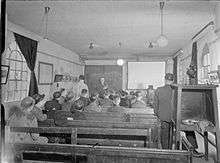
Boys when they were nearly 18 years old received an official postcard instructing them in five days time to report to a training centre such as at Cresswell Colliery, Derbyshire.[29]
Bevin Boys with no previous experience of mining, were given six weeks' training (four in a classroom-type setting and two at their assigned colliery).[20] For their first four weeks of underground work, they were supervised by an experienced miner.[20] With the exception of those working in the south Wales coalfields, the conscripts could not work at the coalface until they had accrued four months' experience underground.[20]
For the most part, the Bevin Boys were not directly involved in cutting coal from the mine face, but acted instead as colliers assistants, responsible for filling tubs or wagons and hauling them back to the shaft for transport to the surface.[4] Conscripts were supplied with helmets and steel-capped safety boots.
Pay and working conditions
Almost as soon as the first Bevin Boys had reported for training, there were complaints that their remuneration (44 shillings per week for an 18-year-old) were barely sufficient to cover living costs.[30] Some 140 went on strike in Doncaster for two days before their training had finished.[31] There were also complaints from experienced miners, who resented the fact that a 21-year-old recruit received the same minimum wage as they did.[32]
Bevin Boys did not wear uniforms or badges, but the oldest clothes they could find. Being of military age and without uniform caused many to be stopped by police and questioned about avoiding call-up.[33]
Contemporary attitudes to Bevin Boys
Many Bevin Boys suffered taunts as they wore no uniform, and there were accusations by some people that they were deliberately avoiding military conscription. Since a number of conscientious objectors were sent to work down the mines as an alternative to military service (under a system wholly separate from the Bevin Boy programme), there was sometimes an assumption that Bevin Boys were "Conchies". The right to conscientiously object to military service for philosophical or religious reasons was recognised in conscription legislation, as it had been in the First World War. However, old attitudes still prevailed amongst some members of the general public, with resentment by association towards Bevin Boys. In 1943 Ernest Bevin said in Parliament:
- There are thousands of cases in which conscientious objectors, although they have refused to take up arms, have shown as much courage as anyone else in Civil Defence and in other walks of life.
- Ernest Bevin, 9 December 1943[34]
End of programme
The final conscription ballot took place in May 1945 (shortly before VE Day), however the final conscripts were not released from service until March 1948.
Recognition of contribution to the war effort
Within a few months of the first Bevin Boys starting work, there were calls for a badge to be awarded in recognition of the importance of their national service,.[35]
After the war, Bevin Boys received neither medals nor the right to return to the jobs they had previously held.[4] (Like Forces veterans, they were entitled to participate in the Government's Further Education and Training Scheme, which paid university fees and an annual means-tested grant of up to £426 to cover living expenses whilst studying.[36])
The role played by Bevin Boys in Britain's war effort was not fully recognised until 1995, 50 years after VE Day, when Queen Elizabeth II mentioned them in a speech.[37]
On 20 June 2007, Tony Blair informed the House of Commons that thousands of conscripts who worked in mines during the Second World War would be awarded a veterans badge similar to the HM armed forces badge awarded by the Ministry of Defence.[38] The first badges were awarded on 25 March 2008 by the then Prime Minister, Gordon Brown, at a reception in 10 Downing Street, marking the 60th anniversary of discharge of the last Bevin Boys.[39]
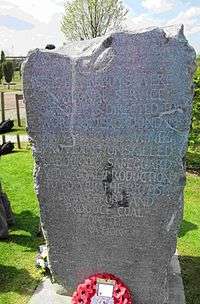
On Tuesday 7 May 2013, a memorial to the Bevin Boys, based on the Bevin Boys Badge, was unveiled by the Countess of Wessex at the National Memorial Arboretum at Alrewas, Staffordshire.[40][41] The memorial was designed by former Bevin Boy Harry Parkes; it is made of four stone plinths carved from grey Kilkenny stone from the Republic of Ireland. The stone should turn black over time, to resemble the coal that the miners extracted.[41]
The Bevin Boys Association is trying to trace all 48,000 Bevin Boy conscripts, optants or volunteers who served in Britain's coal mines during and after the war, from 1943 to 1948.[42]
Notable Bevin Boys
- Peter Archer, lawyer and Labour Party politician[43]
- Stanley Bailey, senior police officer[44]
- Stanley Baxter, actor and impressionist[45]
- John Comer, actor[46]
- Geoffrey Finsberg, Conservative politician[47]
- Roy Grantham, trade union leader[48]
- Paul Hamlyn,[49] founder of the Hamlyn group of publishers and Music for Pleasure record label
- Wally Holmes, rugby union player
- Nat Lofthouse, footballer[50]
- Dickson Mabon, Labour politician[51]
- Tom McGuinness, artist[52]
- David McClure, artist
- Eric Morecambe,[53] comedian
- Alun Owen, screenwriter[54]
- Kenneth Partridge, interior designer[55]
- Jock Purdon,[56] folk singer/poet
- Peter Alan Rayner, numismatic author
- Brian Rix,[53] actor/manager, and president of Mencap
- Peter Shaffer,[57] dramatist
- Jimmy Savile, disgraced radio/television personality
- Alf Sherwood, footballer
- Gerald Smithson, cricketer
Bevin Boys Association
The Bevin Boys Association was formed in 1989 with a small membership of 32 in the Midlands area. By 2009 the membership had grown to over 1,800 from all over the United Kingdom and overseas.
Today the Bevin Boys Association continues to hold meetings and reunions as well as attending commemoration services.
The society produces a newsletter for all members.
In popular culture
Douglas Livingstone's radio play, Road to Durham, is a fictional account of two former Bevin Boys, now in their eighties, as they visit the Durham Miners' Gala.[58]
British musician Jez Lowe wrote the song "The Sea and the Deep Blue Devil" from the perspective of a Bevin Boy who loses his girlfriend to a Royal Navy recruit.[59]
See also
- Unfree labour – a related, although different concept; labour in time of war or national emergency is specifically exempted from the category of 'unfree labour', as is work related to fulfilling a civic obligation.
References
- Bevin Boys – BERR Archived 14 July 2009 at the Wayback Machine
- "Historical coal data: coal production, availability and consumption". UK Government. 25 January 2019. Retrieved 23 April 2020.
- "Bevin, Ernest". Oxford Dictionary of National Biography (online ed.). Oxford University Press. doi:10.1093/ref:odnb/31872. (Subscription or UK public library membership required.)
- "Remembering the Bevin Boys in the Second World War". National Museum Wales. 3 January 2008. Retrieved 24 April 2020.
- Leslie, Hannah (1979). "War and Post-war Crisis". Electricity before Nationalisation. London: Macmillan. pp. 289–328. ISBN 978-0-333-22086-3.
- "Kent coal strike over". The Times (49146). London. 29 January 1942. p. 2.
- "Colliery Taken Over By Mines Department". The Times (49250). London. 1 June 1942. p. 4.
- "Miners Accept Wage Award". The Times (49270). London. 24 June 1942. p. 2.
- "The Coal Plan". The Times (49253). London. 4 June 1942. p. 5.
- "Bonus on coal output". The Times (49328). London. 31 August 1942. p. 2.
- "Increased output of coal". The Times (49368). London. 16 October 1942. p. 2.
- "Coal output up slightly". The Times (49417). London. 12 November 1942. p. 2.
- "Coal output still below standard". The Times (49442). London. 13 January 1943. p. 2.
- HC Deb, 29 May 1945 vol 411 c109
- "Urgent call to miners". The Times (48960). London. 24 June 1941. p. 2.
- "No more miners for the army". The Times (48961). London. 25 June 1941. p. 5.
- "Coal output up". The Times (49702). London. 13 November 1943. p. 2.
- Bevin, Ernest (December 1943) [1st broadcast 12 November 1943]. "A call to youth for the coal mines". British Speeches of the Day. 10. London: British Information Services. pp. 22–24.
- HC Deb, 12 October 1943 vol 392 cc764-766
- HC Deb, 2 December 1943 vol 395 cc521-529
- "Young men for the mines". The Times (49719). London. 3 December 1943. p. 4.
- "First "Bevin Boys" start work". The Times (49779). London. 14 February 1944. p. 2.
- "Bevin Boy loses appeal". The Times (49821). London. 3 April 1944. p. 2.
- "Bevin Boy changes his mind". The Times (49830). London. 14 April 1944. p. 2.
- "Prison for Bevin Boy". The Times (49942). London. 23 August 1944. p. 2.
- "Bevin Boy cases". The Times (49953). London. 6 September 1944. p. 8.
- HC Deb, 15 June 1944 vol 400 c2105
- HC Deb, 14 December 1944 vol 406 c1328
- Interview 29 August 2019 with ex-Bevin Boy Kenneth Jones born 1926.
- "Grievances of Bevin Boys". The Times (49758). London. 20 January 1944. p. 8.
- "Pit recruits go back". The Times (49760). London. 22 January 1944. p. 4.
- "Coal strikes continued". The Times (49802). London. 11 March 1944. p. 4.
- Called Up Sent Down : The Bevin Boys' War – Tom Hickman Pub. The History Press 2008 ISBN 0-7509-4547-8
- HC Deb, 9 December 1943 vol 395 c1108
- "Young mine workers". The Times (49870). London. 31 May 1944. p. 8.
- Dent, Harold Collett (2007). "1". Growth in English education, 1946-1952. London: Routledge. ISBN 9780415432160.
- "Bevin's Boys – British Conscripts Forced To Mine Coal – Kept in the Dark for Over 70 Years". Retrieved 31 August 2019.
- "Bevin Boys' war effort honoured with badge". The Daily Telegraph. Retrieved 31 August 2019.
- "Bevin Boys honoured". The Times (69281). London. 26 March 2008. p. 4.
- "Court Circular". The Times (70879). London. 8 May 2013. p. 51.
- "Bevin Boys memorial unveiled by Countess of Wessex". The Daily Telegraph. Retrieved 12 May 2013.
- "Bevin Boys Association entry on Culture24". Retrieved 16 December 2009.
- "Lord Archer of Sandwell". The Times (70605). London. 21 June 2012. p. 51.
- "Sir Stanley Bailey". The Times (69406). London. 19 August 2008. p. 53.
- "Glasgow-born comedy star Stanley Baxter shows no sign of ending his love with radio". Glasgow Times. Retrieved 23 January 2020.
- http://afternoontea.mpt.org/tea-time-tidbits/060914/
- "Lord Finsberg". The Times (65705). London. 10 October 1996. p. 23.
- "Roy Grantham". The Times (71043). London. 15 November 2013. p. 70.
- Mosse, Werner Eugen; Carlebach, Julius. Second chance: two centuries of German-speaking Jews in the United Kingdom. Mohr Siebeck. p. 376. ISBN 9783161457418. Retrieved 10 May 2013.
- "Bolton Council-Bolton's Bevin Boys remembered". Archived from the original on 27 September 2011. Retrieved 18 December 2012.
- "Dr Dickson Mabon". The Times (69298). London. 15 April 2008. p. 54.
- "Lives in brief". The Times (68637). London. 2 March 2006. p. 70.
- Cooke, Ken (2007). History of the Percy Jackson Grammar School: Adwick-le-Street, Doncaster, Yorkshire, 1939–1968 : Recollections of Schooldays of the 1940s, 1950s & 1960s. Troubador Publishing Ltd. p. 6. ISBN 9781905886784.
- "Alun Owen". The Times (65132). London. 8 December 1994. p. 23.
- "Kenneth Partridge, interior designer – obituary". The Telegraph. 21 December 2015. Retrieved 21 January 2016.
- English Dance & Song. 41–44. English Folk Dance and Song Society. 1979. p. 18.
- Morton, Ray (2011). Amadeus: Music on Film Series. Hal Leonard. p. 21. ISBN 9780879104177.
- Giddings, Robert (30 April 2009). "RADIO: Seamless drama goes underground to dig deep for victory". Tribune. Retrieved 25 August 2011.
- Foster, Richard (10 May 2007). "Jez Lowe, Jack Common's Theme (Tantobie Records)". The Press. Retrieved 4 May 2020.
External links
| Wikimedia Commons has media related to Bevin Boys. |